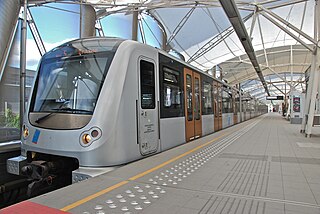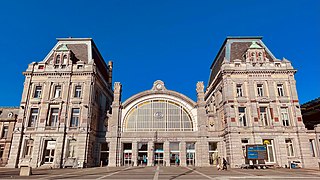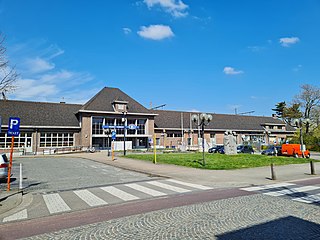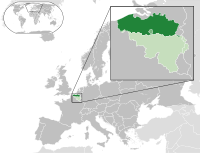
Transport in Belgium is facilitated with well-developed road, air, rail and water networks. The rail network has 2,950 km (1,830 mi) of electrified tracks. There are 118,414 km (73,579 mi) of roads, among which there are 1,747 km (1,086 mi) of motorways, 13,892 km (8,632 mi) of main roads and 102,775 km (63,861 mi) of other paved roads. There is also a well-developed urban rail network in Brussels, Antwerp, Ghent and Charleroi. The ports of Antwerp and Bruges-Zeebrugge are two of the biggest seaports in Europe. Brussels Airport is Belgium's biggest airport.

West Flanders is the westernmost province of the Flemish Region, in Belgium. It is the only coastal Belgian province, facing the North Sea to the northwest. It has land borders with the Dutch province of Zeeland to the northeast, the Flemish province of East Flanders to the east, the Walloon province of Hainaut in the south and the French department of Nord to the west. Its capital is Bruges (Brugge). Other important cities are Kortrijk in the south and Ostend (Oostende) on the coast, Roeselare and Ypres (Ieper). The province has an area of 3,197 km2 (1,234 sq mi) which is divided into eight administrative districts (arrondissementen) containing 64 municipalities. As of January 2019, West Flanders has a population of 1,195,796.

The Flemish Region, usually simply referred to as Flanders, is one of the three regions of Belgium—alongside the Walloon Region and the Brussels-Capital Region. Covering the northern portion of the country, the Flemish Region is primarily Dutch-speaking. With an area of 13,522 km2 (5,221 sq mi), it accounts for only 45% of Belgium's territory, but 57% of its population. It is one of the most densely populated regions of Europe with around 490/km2 (1,300/sq mi).

Vlaamse Vervoersmaatschappij De Lijn, usually known as De Lijn, is a company run by the Flemish government in Belgium to provide public transportation with about 2240 buses and 399 trams. De Lijn was founded in 1991 after the public transportation companies of Antwerp and Ghent fused with the Flemish part of the NMVB.

The Coast Tram is a light rail public transport service connecting the cities and towns along the Belgian coast between De Panne, near the French border, and Knokke-Heist, near the Dutch border. At 67 kilometres (42 mi) in length, it is currently the world's longest metre gauge tram line in service, and the second-longest light rail service in the world after the A Line of the Los Angeles Metro Rail system, as well as one of the few interurban tramways in the world to remain in operation. The line is fully electrified at 600 V DC.

Gent-Sint-Pieters railway station is the main railway station in Ghent, East Flanders, Belgium, and the fourth-busiest in Belgium and busiest in Flanders, with 17.65 million passengers a year. The station is operated by the National Railway Company of Belgium (NMBS/SNCB).

Ostend–Bruges International Airport, commonly known simply as Ostend Airport, is an international airport located 2.7 nautical miles south southwest of Ostend, Belgium, near the coast and about 25 km (16 mi) from central Bruges.
Science and technology in Flanders, being the Flemish Community and more specifically the northern region of Belgium (Europe), is well developed with the presence of several universities and research institutes. These are strongly spread over all Flemish cities, from Kortrijk and Bruges in the Western side, over Ghent as a major university center alongside Antwerp, Brussels and Leuven to Hasselt and Diepenbeek in the Eastern side.

Gent-Dampoort railway station is the second largest railway station in Ghent, East Flanders, Belgium. It is situated in the Dampoort neighbourhood, after which it is named.

Brugge railway station is the main railway station in Bruges, West Flanders, Belgium. The station opened on 12 August 1838 on railway lines 50A, 51 and 66. The current building has been in use since 1939. The station is one of the busiest in Belgium. The train services are operated by the National Railway Company of Belgium (NMBS/SNCB).

Kortrijk railway station is the main railway station in Kortrijk, West Flanders, Belgium. The station was first inaugurated on 22 September 1839. With around 10,000 passengers per day, Kortrijk is the fifteenth-busiest railway station in Belgium, and the second in West Flanders. It is operated by the National Railway Company of Belgium (NMBS/SNCB).

The Ghent tramway network is a network of tramways forming part of the public transport system in Ghent, a city in the Flemish Region of Belgium, with a total of four lines. Since 1991, the network has been operated by De Lijn, the public transport entity responsible for buses and trams in Flanders.

Brussels has an extensive network of both private or public transportation means. Public transportation includes Brussels buses, trams, and metro, as well as a set of railway lines and railway stations served by public trains. Air transport is available via one of the city's two airports, and boat transport is available via the Port of Brussels. Bicycle-sharing and car-sharing public systems are also available. The city is relatively car-dependent by northern European standards and is considered to be the most congested city in the world according to the INRIX traffic survey.

The Belgian railway line 50A is a railway line in Belgium connecting Brussels with Ostend through Ghent and Bruges. The section between Ghent and Ostend was completed in 1838. The section between Ghent and Brussels was opened between 1923 and 1933, offering a faster connection than the existing line 50. The total length of the line is 114.3 km.

Bruges is the capital and largest city of the province of West Flanders in the Flemish Region of Belgium, in the northwest of the country. It is the sixth most populous city in the country.

Oostende railway station is a railway station in Ostend, West Flanders, Belgium. It is operated by the National Railway Company of Belgium (NMBS/SNCB).

Knokke railway station is a railway station serving Knokke-Heist and Knokke, in West Flanders, Belgium. The station was built in 1920. It is run by the National Railway Company of Belgium (NMBS/SNCB) as a terminal station located on the railway line 51B from Brugge and has services to Brussels-South and beyond to Tongeren. The Kusttram terminus is located outside the station with trams to Oostende and beyond.

Blankenberge railway station is a railway station in Blankenberge, West Flanders, Belgium. The station opened on 16 August 1863 on railway line 51. It is run by the National Railway Company of Belgium (NMBS/SNCB) as a terminal station located on the railway line from Brugge and has services to Brussels-South and beyond to Leuven.

Lokeren railway station is a railway station in Lokeren, East Flanders, Belgium. The station opened on 9 August 1847 and is located on railway lines 57 and 59. The train services are operated by the National Railway Company of Belgium (NMBS/SNCB).





















